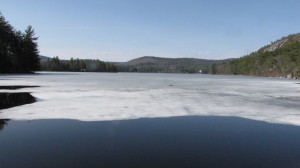Ice 101 for Maine Lakefront Property Owners
Out and About for the Belgrade Lakes Region of Maine Nov. 20-26
November 19, 2014Classic Maine Log Cabin On Crystal Lake in Gray Offers Cozy Ambiance
November 23, 2014Ice 101 for Maine Lakefront Property Owners
Ice on Bear Pond in Quintessential Waterford, Maine
by Leigh Macmillen Hayes
Ice. The great protector. As a lakefront property owner, have you ever thought about it that way?
I know–you think about it as being a pain because you need to take the dock out in the fall and then wait until ice-out in the spring to put it back in. But that’s only an issue for you twice a year.
Ice is important for some other real estate in your lakefront neighborhood–the shoreline that harbors plants and animals.
Think about life under the ice. Because of water’s unique properties, it expands when frozen, unlike other things that contract when they freeze. If you forgot to drain the pipes of your camp or cabin, or you didn’t add enough antifreeze, you know this all too well.
Once water freezes, it floats. While new ice forms below what we see on the surface, there is still room for fish and other aquatic critters to use oxygen. Yes, the ice becomes an insulating layer–keeping out the wind, lowering the amount of light and preventing evaporation.
Of course, oxygen production does stop so there is no increase in the level available. But, fish and other organisms that depend on oxygen have learned to budget their intake by lowering their metabolism during the winter.
Warmwater species such as largemouth and smallmouth bass–they become less active so that they don’t need as much food or oxygen. Coldwater species, like lake trout, have a higher metabolism and continue to forage. These are the guys you’ll catch while ice fishing.
As part of the ecosystem, the “wetland” areas of a lake, where plants are abundant, is also the place where invertebrates and small fish feed. And these provide forage for the predatory fish.
The marshier areas also serve as a nursery for fish. Thanks to the ice, wind and wave action don’t affect fragile eggs and move them about.
It’s not just fish that are protected by the ice. Reptiles and amphibians overwinter by hibernating in the sediment–the mud at the bottom of your lake or pond.
So . . . even though you don’t see it happening, ice helps these species get through a cold winter season.
With that in mind, we want you to also get through the season safely while enjoying time spent on your ice or snow-covered lake–ice fishing, skating, snowmobiling, cross-country skiing and star gazing.
Always check ice thickness before heading out. Temperature, snow cover, currents and springs all affect the relative safety of ice. And ice is seldom the same thickness over a single body of water, therefore, it’s wise to check the thickness at least every 150 feet.
The following is a list of recommendations from the Maine Warden Service:
General Ice Thickness Guidelines – For New, Clear Ice Only:
2″ or less – STAY OFF
4″ May allow Ice fishing or other activities on foot
5″ often allows for snowmobile or ATV travel
8″ – 12″ of good ice with supports most cars or small pickups
12″ – 15″ will likely hold a medium sized truck.
Remember that these thicknesses are merely guidelines for new, clear, solid ice. Many factors other than thickness can cause ice to be unsafe.
Source: www.maine.gov/ifw/warden_service/safety
To learn more about lakefront property for sale in Waterford, Maine, click on the green box above.
To learn more about the Waterford area in the Sebago Lakes Region of Maine, check out the blog links below:
Papoose Pond, North Waterford, Maine: Natural Beauty Awaits
Waterford, Maine, the Quintessential New England Town in the Sebago Lakes Region

